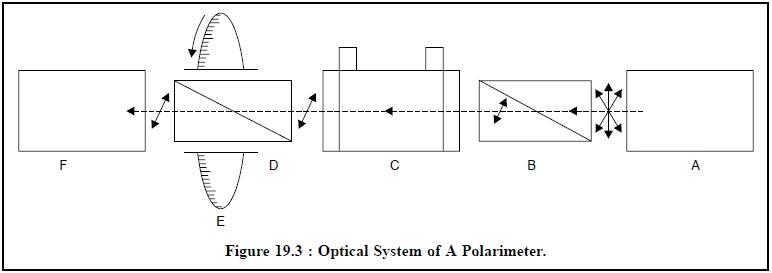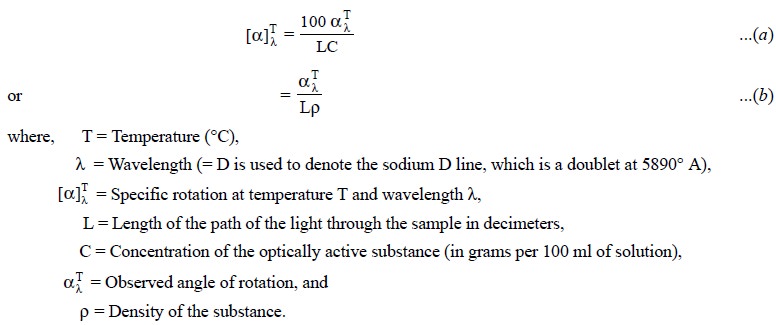Chapter: Pharmaceutical Drug Analysis: Polarimetry
Polarimetry: Instrumentation

INSTRUMENTATION
The rotation of the plane of polarized light and hence
the optical activity may be detected and measured accurately by an instrument
known as the polarimeter

Figure 19.3, represents the optical system of a
polarimeter,
A = Collimated monochromatic light source,
B = Polarizing prism (Nicol),
C = Polarimeter glass tube (20 cm) with glass windows,
D = Analyzing rotator prism (Nicol),
E = Circular scale with vernier,
F = Null detector (Eye or Photoelectric Cell).
Principle :
The underlying principle of a
polarimeter is that light from the source, usually a sodium vapour lamp, first gets collimated at A, and subsequently falls
upon polarizer B (a calcite prism).
The polarizer permits only the light polarized in a particular direction to
pass it. The emergent polarized ray now passes through the sample under
investigation, kept in the polarimeter glass tube C to the analyzer D, which
happens to be another polarizing prism. The analyzing rotator prism D (Nicol) is fixed in such a manner that
it can be rotated easily about the axis of the incident light ray. Two
situations arise when the analyzing rotator prism (D) is put into action, firstly, the prism being parallel to the
plane of polarization of the incident light—the net result is that the
intensity of light reaching the Null detector F is maximum ; and secondly, the prism being perpen-dicular
to the plane of the polarized light—the net result is observed by the intensity
of light reaching the detector as minimum. Hence, the overall difference in the
position of the analyzer, as noted from the circular scale E, that provides
minimum light intensity with and without the sample in the cell is the observed
‘rotation’ of the sample in question.
Specific Rotation :
A polarized light when passed
through an optically active substance, each mol-ecule of it encountered by the
light beam rotates the plane of polarization by a constant amount characteristic
of the substance. Consequently, a measure of the rotary power of the individual
molecule, irrespective of the two parameters, namely : the path length and the
concentration, is achieved by converting the measured rotation into a specific
rotation by the help of the following expressions :

Related Topics